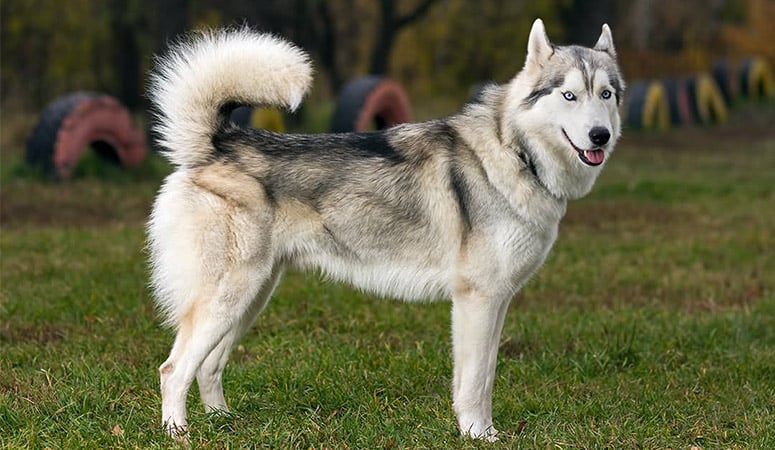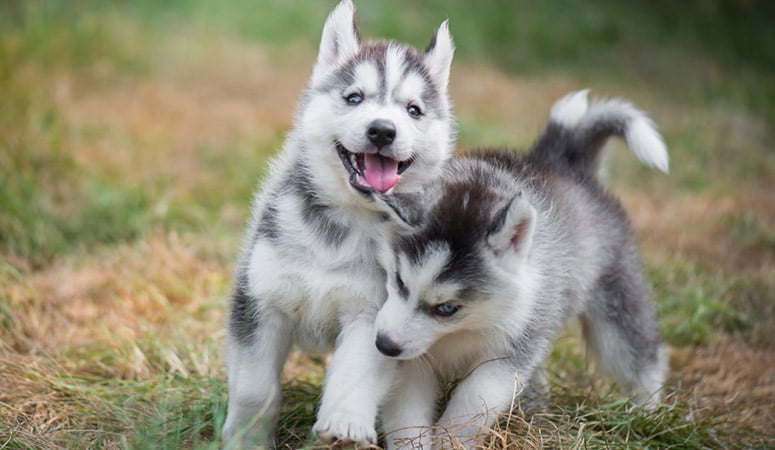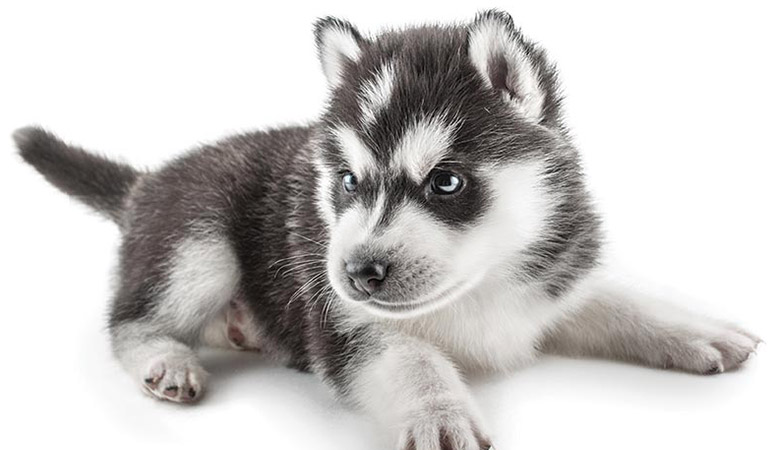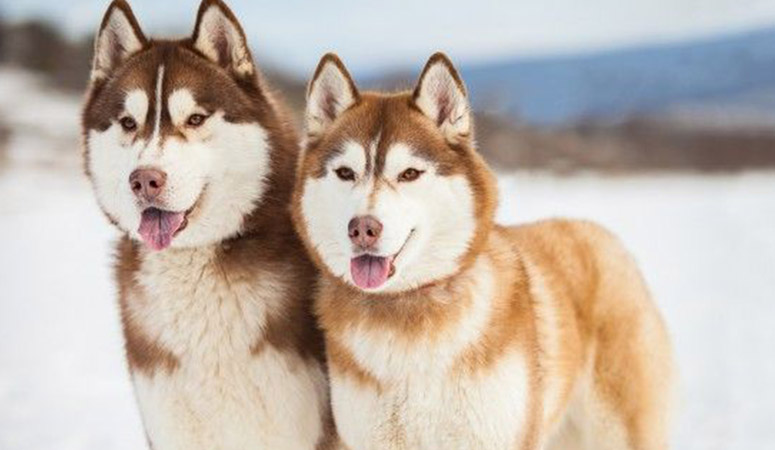Siberian Husky
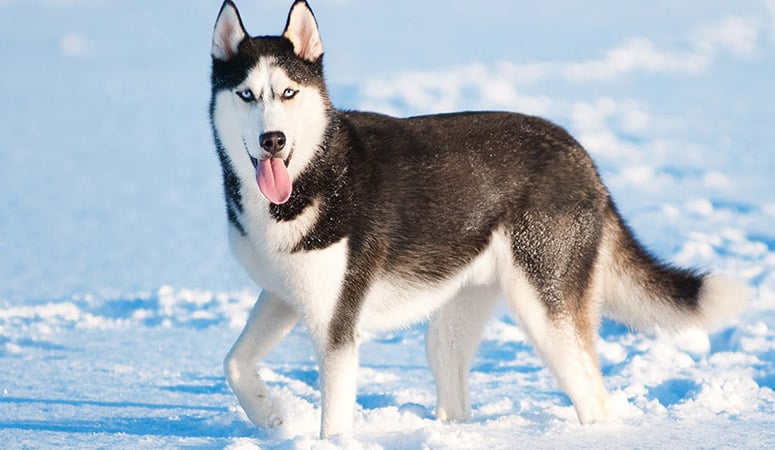
The Siberian Husky, a medium-sized working dog breed, has a beautiful, thick coat, is sledding, guarding, and companionship of Chukchi people. Their expressions are often sharp but friendly, interested, and sometimes naughty, and their blue or multi-colored eyes and eye-catching facial mask increase the charm of this Siberian breed.
| Other Names | Arctic Husky |
| Color | Agouti & White, Black, Black & White, Black Tan & White, Brown & White, Gray & White, White, Sable & White, Red & White |
| Height | Males: 20-24 inches. Females: 19-22 inches. |
| Weight | Males: 45-60 pounds. Females: 35-50 pounds. |
| Life Span | 12-14 years |
| Personality | Loyal, Mischievous, Outgoing |
| Exercise | Energetic |
| Origin |
| Popularity | #15 |
| Groom Needs | Weekly |
| Kids Friendly | Yes with supervision |
| Dog Friendly | Yes |
| Watch Dog | |
| Family Dog | Yes |
| Litter Size | 4-8 |
Siberian Husky Pictures
Siberian Husky Video
Introduction
The Siberian Husky and the Alaskan Malamute are undeniably similar in appearance, they could easily be mistaken, one for the other. Both descendants of the original sled dogs of Arctic, the Siberian Husky is distinguishable by its smaller and lighter frame under the thickly furred coat. The coat can take on any color from black to white, or even red.
The tendency to break into a run, chasing little quarry is aided by their lightweight and powerful, yet graceful gait. A male Siberian Husky would tip the weighing scales at around 55 pounds while the female pulls a 45 pound-weight. Being medium-sized dogs, the Siberian Huskies reach a shoulder height of about 22 inches on the average. This breed of dogs can be friendly and yet mischievous. Though may serve as watchdogs, they do better as work-dogs, best for endurance work. A Siberian Husky has an average life expectancy of about 13 years.
Living with Siberian Husky
Siberian Huskies have a thick double coat, so it brings some important factors to note about the grooming. First, the shedding can be a problem to them, Siberian Huskies shed regularly, besides, heavily shed the undercoat once or twice a year – in the spring and the fall. If you live in a colder climate, this can be a little better.
During the peak shedding season, a shed blade or coat rake is needed to Siberian Husky and a slicker brush is fine for the rest of the year. Siberian is a very clean dog with little to no odor, and most Siberian Huskies only need a bath a few times a year or when they get especially dirty.
Also, you should check your ears once a week for signs of infection, irritation, or wax accumulation. Brush their teeth at least once a week to prevent tartar build-up and resist gum disease. In addition, the dog nails should be trimmed once a month.
Siberian Huskies are active, athletic dogs who need a lot of exercises. They are a working breed and need a “job” to make them happy and healthy, such as weight pulling, flyball, obedience. Regular exercise is important for both body and spirit, and exercising together can strengthen the connection between the dog and the owner.
If proper exercise is performed, the dog can be made quite quiet and alert. If they don’t get enough exercise, the dog may be overactive and destructive. Siberian Huskies need to take a long walk or jog exercise every day. Siberian Husky owners should also make sure that they are kept on the leash and safe because this breed has a strong desire to run.
Yet, Husky young puppies shouldn’t get too much exercise, because their joints and bones are still growing and applying too much pressure to them may cause some problems in the dog’s future life.
Fats and protein are the most important sources of energy to a Siberian Husky, you can feed your dog with high-quality dry dog food, but it is not recommended to add chopped chicken, liver, fish or other meat as supplements by casual.
The working Siberian Husky needs to adjust the level of protein in the food according to activity levels. It is best to feed the adult dog twice a day, once in the morning and again in the evening to ensure that it meets all nutritional needs and is quality food.
It is also important to give dogs an appropriate amount of exercise so that they burn off excess calories or gain too much weight causing various health problems. Obesity shortens the dog’s lifespan by several years, so attention must be paid to the dog’s waistline from the beginning.
Snacks may be an important aid in training, but excessive intake can lead to obesity. Learn about which human’s food is safe for dogs and which is not. If you have any questions about the dog’s weight or diet, please consult your veterinarian. And there should be clean fresh water for the dogs at all times.
The Siberian Husky breed is generally a healthy one. There are still a few concerns to watch out for, including crystalline corneal opacity, epilepsy, hip dysplasia, hypothyroidism, juvenile cataracts, nasal depigmentation, basal cell tumor, perianal gland adenoma.
Occasionally seen: CHD
Minor concerns: PRA, cataract, corneal dystrophy, hypothyroidism
Suggested tests:
Hip Evaluation
Ophthalmologist Evaluation
Total Annual Cost: $3245
Cost is estimated for the first year and may vary depending on many factors, such as dog food, health care, leash, collar, licensing, possible fencing, crates, training and obedience classes, dog-walking, grooming, treats, toys, flea, tick, and heart-worm meds, microchips, etc.
The Siberian Husky is very sociable and often needs the company of their people or other dogs, they are not suitable for being alone all day. Most importantly, Huskies have an overwhelming desire to run and they should always be on a leash or safely enclosed in a fence all the time and never allowed to off lead.
Although the Siberian Husky may be not good at obedience skills, you can train her to do some tricks. Once she understands some basic commands, she can probably handle navigating an agility course. They can also learn “shake” or even waving “Hello”. She will be happy to participate in the game fetching and hide-and-seek, and unlike most other dog breeds, she can be trained to “sing” (howl) under the command, which is a particularly flattering talent. And these advanced activities could help stimulate and encourage Husky’s curiosity and intelligence.
History
Sled dogs have been around since some 9,000 years ago. They provided a convenient means of transportation in the Arctic regions before the era of snow-mobiles. The Chukchi people of ancient Siberia, in Northeast Asia, were renowned for the breeding draft and sled dogs, and their popularity consisted in the fact that they bred the lighter and faster variety at the time when the hefty type was preferred in other regions of the world.
It wasn’t long before the Chukchi sled dogs gained popularity as they were favored in their ability to perform endurance work and travel vast distances which were the growing need at the time, as there were no freight vehicles. These sled dogs were continually bred and a number of different hybrids are known. The Siberian Husky is the modern breed of these hybrids, although its origin can be linked to Russia.
Although the Siberian Husky had begun to gain prominence around the 19th century, it took another century for its recognition in the U.S, where it was first introduced through the Bering Strait.
The history of this Arctic dog breed wouldn’t be complete without mention of the heroic services they had engaged in during emergency situations. To mention a prominent example; the story of the ‘Great Race for Mercy’ in 1925 during diphtheria endemic in Nome made heroes out of the Siberian Husky breed for their involvement in the over 600-mile serum run to Nome. Notable dog names on this mission were Balto and Togo.
Since they achieved fame as endurance work-dogs and sled dogs, Siberian Huskies have been used in many military operations and scientific expeditions in Antarctica. The Siberian Husky was so named in 1991 by the United Kennel Club which initially regarded it as the Arctic Husky.
Helpful Information
Breed Club: SIBERIAN HUSKY CLUB OF AMERICA, INC.
Breed Club Link: https://www.shca.org/
Breed Club Rescue: SHCA Trust Rescue
Breed Club Rescue Link: http://www.shcatrust.org/rescue.html

